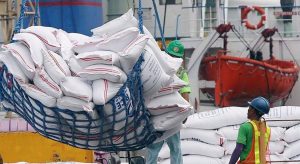THE PHILIPPINES’ rice imports totaled 2.37 million metric tons (MT) as of July 11, according to data from the Bureau of Plant Industry.
Shipments for the first two weeks of July alone amounted to 35,594 MT, data from the agency showed. These were already imported under the lower tariff regime, Agriculture Assistant Secretary and Spokesperson Arnel V. de Mesa said in a briefing on Friday.
Last month, President Ferdinand R. Marcos, Jr. signed Executive Order (EO) No. 62, which lowered the tariff on imported rice to 15% from 35% until 2028. The order is aimed at reducing prices of the staple.
The Department of Agriculture (DA) earlier said the EO is expected to lower the retail price of rice by about P6 to P7 per kilogram.
Meanwhile, in the first semester, rice imports amounted to 2.33 million MT, 25.3% higher than the 1.86 million MT recorded in the same period last year, the data showed.
Vietnam remained the top supplier of rice with total shipments at 1.76 million MT as of July 11, accounting for 74.3% of the total.
The Philippine and Vietnamese governments signed an agreement giving the Philippines an annual quota of 1.5 million to 2 million MT of rice for five years.
Thailand supplied 358,727 MT during the period or 15.1% of the total. It was followed by Pakistan with 151,883 MT or a 6.4% share.
Rounding out the top five were Myanmar and India, which shipped 66,120 MT (2.7%) and 21,745 MT (0.92%) of rice, respectively.
The Philippines imports about 20% of its rice requirement amid insufficient domestic production.
The US Department of Agriculture raised its Philippine rice import estimates for 2024 to 4.7 million MT from 4.6 million MT previously due to the increased shipments seen during the first half of the year.
Meanwhile, palay or umilled rice production is projected to decline by 8.6% to 3.88 million MT this year from the 4.25 million MT in actual output in 2023, according to the Philippine Statistics Authority. For its part, Agriculture department expects palay output to hit 20.44 million MT in 2024.
Former Agriculture Undersecretary Fermin D. Adriano said rice imports may pick up further in the coming months due to the projected decline in production amid the El Niño weather phenomenon and the incoming La Niña spell during the fourth quarter.
Rice imports may increase amid the reduced tariff on the commodity, Federation of Free Farmers National Manager Raul Q. Montemayor added.
“Retail prices would be around P50 per kilo — maybe lower but not by much, or it could go higher if traders are able to sell higher in order to increase their profits,” Mr. Montemayor said in a Viber message.
“We will also have to watch Vietnam if they will raise their export prices in response to the tariff cut to 15%,” he added.
According to the DA’s price monitoring of Metro Manila markets, imported well-milled rice cost between P51 and P54 per kilo as of July 20, while regular milled rice cost was priced at P47-49 a kilo. — A.H. Halili
